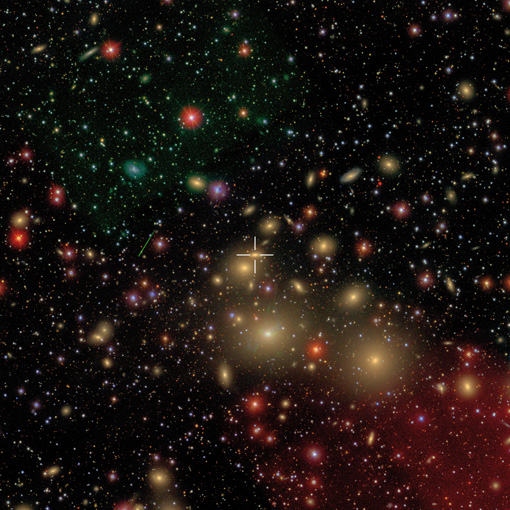Giant black hole could upset galaxy evolution models
November 30, 2012

Image of the disk galaxy (lenticular galaxy) NGC 1277, taken with the Hubble Space Telescope. This small, flattened galaxy contains one of the biggest central super-massive black holes ever found in its center. With the mass of 17 billion Suns, the black hole weighs in at an extraordinary 14% of the total galaxy mass. (Credit: NASA/ESA /Andrew C. Fabian/Remco C. E. van den Bosch (MPIA))
A group of astronomers led by Remco van den Bosch from the Max Planck Institute for Astronomy (MPIA) have discovered a black hole that could shake the foundations of current models of galaxy evolution.
At 17 billion times the mass of the Sun, its mass is much greater than current models predict — in particular in relation to the mass of its host galaxy. This could be the most massive black hole found to date.
To the best of our astronomical knowledge, almost every galaxy should contain in its central region what is called a supermassive black hole: a black hole with a mass between that of hundreds of thousands and billions of Suns. The best-studied super-massive black hole sits in the center of our home galaxy, the Milky Way, with a mass of about four million Suns.

NGC 1277 is embedded in the nearby Perseus galaxy cluster, at a distance of 250 million light-years from Earth. All the ellipticals and round yellow galaxies in the picture are galaxies located in this cluster. Compared to all the other galaxies around it, NGC 1277 is a relatively compact. (Credit: David W. Hogg, Michael Blanton, and the SDSS Collaboration)
For the masses of galaxies and their central black holes, an intriguing trend has emerged: a direct relationship between the mass of a galaxy’s black hole and that of the galaxy’s stars.
Typically, the black hole mass is a tiny fraction of the galaxy’s total mass. But now a search led by the Dutch astronomer Remco van den Bosch (MPIA) has discovered a massive black hole that could upset the accepted relationship between black hole mass and galaxy mass, which plays a key role in all current theories of galaxy evolution.
With a mass 17 billion times that of the Sun, the newly discovered black hole in the center of the disk galaxy NGC 1277 might even be the biggest known black hole of all: the mass of the current record holder is estimated to lie between 6 and 37 billion solar masses (McConnell et al. 2011).
The big surprise is that the black hole mass for NGC 1277 amounts to 14% of the total galaxy mass, instead of usual values around 0.1%.
This beats the old record by more than a factor of 10. Astronomers would have expected a black hole of this size inside blob-like (“elliptical”) galaxies ten times larger. Instead, this black hole sits inside a fairly small disk galaxy.

The Hobby-Eberly Telescope at McDonald Observatory in Texas (credit: Damond Benningfield)
Is this surprisingly massive black hole a freak accident? Preliminary analysis of additional data suggests otherwise — so far, the search has uncovered five additional galaxies that are comparatively small, yet, going by first estimates, seemed to harbor unusually large black holes too. More definite conclusions have to await detailed images of these galaxies.
If the additional candidates are confirmed, astronomers will need to rethink fundamentally their models of galaxy evolution. In particular, they will need to look at the early universe: The galaxy hosting the new black hole appears to have formed more than 8 billion years ago, and does not appear to have changed much since then. Whatever created this giant black hole must have happened a long time ago.
The observations used the Hobby-Eberly Telescope and existing images from the Hubble Space Telescope.
Video: Over-massive black hole in compact galaxy NGC1277
(NGC 1277 is a compact disk galaxy with one of the biggest black holes known to date. Its black hole weighs 17 billion times the mass of the Sun, which amounts to a remarkable 14% of this galaxy’s total mass. Most of the stars in the galaxy are strongly affected by the gravitational pull of this black hole. The black hole was found by van den Bosch and collaborators and published in Nature on 29 November 2012.
The animation shows representative orbits of the galaxy’s stars in this, taken from the dynamical model that was used to measure the black hole mass. The green orbit shows the orbit of the stars in the disk. The red orbit shows the strong gravitational pull near the black hole. The blue orbit is strongly influenced by the (round) dark matter halo. One second in this animation represents 22 million years of simulated time, and the horizontal size of this image amounts to 41 million lightyears (36 arcsec).
This animation has been produced by Remco van den Bosch. It is released under creative commons and can be freely embedded.)
Video: Remco van den Bosch on the giant black hole in the galaxy NGC 1277
(Remco van den Bosch (Max Planck Institute for Astronomy), lead author of the study, describes the discovery of the unusually massive black hole in the galaxy NGC 1277 in this 5 minute video.)